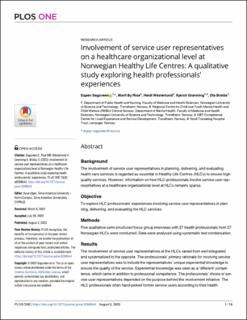| dc.contributor.author | Sagsveen, Espen | |
| dc.contributor.author | Rise, Marit By | |
| dc.contributor.author | Westerlund, Heidi | |
| dc.contributor.author | Grønning, Kjersti | |
| dc.contributor.author | Bratås, Ola | |
| dc.date.accessioned | 2023-11-16T07:29:51Z | |
| dc.date.available | 2023-11-16T07:29:51Z | |
| dc.date.created | 2023-08-22T12:50:45Z | |
| dc.date.issued | 2023 | |
| dc.identifier.issn | 1932-6203 | |
| dc.identifier.uri | https://hdl.handle.net/11250/3102874 | |
| dc.description.abstract | Background
The involvement of service user representatives in planning, delivering, and evaluating health care services is regarded as essential in Healthy Life Centres (HLCs) to ensure high-quality services. However, information on how HLC-professionals involve service user representatives at a healthcare organizational level at HLCs remains sparse.
Objective
To explore HLC professionals’ experiences involving service user representatives in planning, delivering, and evaluating the HLC services.
Methods
Five qualitative semi-structured focus group interviews with 27 health professionals from 27 Norwegian HLCs were conducted. Data were analysed using systematic text condensation.
Results
The involvement of service user representatives at the HLCs varied from well-integrated and systematized to the opposite. The professionals’ primary rationale for involving service user representatives was to include the representatives’ unique experiential knowledge to ensure the quality of the service. Experiential knowledge was seen as a ‘different’ competence, which came in addition to professional competence. The professionals’ choice of service user representatives depended on the purpose behind the involvement initiative. The HLC professionals often hand-picked former service users according to their health problems, motivation, and the HLC’s need. The professionals said they were responsible for initiating the facilitation to accomplish genuine involvement. Support from their leaders to prioritize these tasks was essential.
Conclusion
To meet the demand for adequate service user representatives, the HLCs need access to different service user representatives, representing both diagnose-based and generic service user organisations and the public. To achieve genuine involvement, the rationale behind the involvement and the representatives’ role must be clarified, both for the HLC professionals and service user representatives. This will require resources for continuous organizational preparation and facilitation. | en_US |
| dc.language.iso | eng | en_US |
| dc.publisher | Public Library of Science, PLOS | en_US |
| dc.rights | Navngivelse 4.0 Internasjonal | * |
| dc.rights.uri | http://creativecommons.org/licenses/by/4.0/deed.no | * |
| dc.title | Involvement of service user representatives on a healthcare organizational level at Norwegian Healthy Life Centres: A qualitative study exploring health professionals' experiences | en_US |
| dc.title.alternative | Involvement of service user representatives on a healthcare organizational level at Norwegian Healthy Life Centres: A qualitative study exploring health professionals' experiences | en_US |
| dc.type | Peer reviewed | en_US |
| dc.type | Journal article | en_US |
| dc.description.version | publishedVersion | en_US |
| dc.source.volume | 18 | en_US |
| dc.source.journal | PLOS ONE | en_US |
| dc.source.issue | 8 | en_US |
| dc.identifier.doi | 10.1371/journal.pone.0289544 | |
| dc.identifier.cristin | 2168727 | |
| dc.source.articlenumber | e0289544 | en_US |
| cristin.ispublished | true | |
| cristin.fulltext | original | |
| cristin.qualitycode | 1 | |

